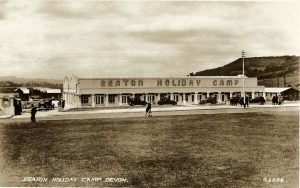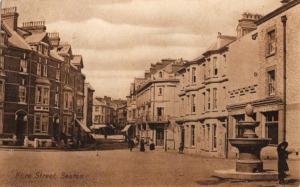The Great Wars
Seaton lost many of its sons during the two world wars that ravaged Europe in the first half of the 20th century. The names of 32 men who died in World War I, and 30 who died during World War II, can be found on the poignant memorial close to the front door of St Gregory’s Church.
Between the wars, during the 1930s, tourism increased and large-scale holiday camps were built to serve the growing demand for accommodation and entertainment along the English coastline. The first chain of such camps was launched by Harry Warner, who pioneered the concept on Hayling Island in 1931 and built a second camp in Seaton in 1935, with the assistance of a certain Billy Butlin, a funfair entrepreneur. Butlin so liked the holiday camp concept that he took the workers he’d employed in Seaton up to Skegness, where he built the first Butlins in 1936.
When World War II erupted in 1939, Warner’s Seaton camp was commandeered and used as an internment camp, where people deemed as ‘enemy aliens’ – a mixture of Germans, Italians, Japanese and others who were resident in Britain at the outbreak of the war, along with those considered to be politically dangerous – were imprisoned.
During World War II Seaton, along with other towns in East and South Devon, also played host to large numbers of American troops, ahead of Operation Overlord and the D-Day invasion of Normandy. Soldiers from the Free Polish and Spanish Armed Forces were also stationed in Seaton. Tragically, many of these men lost their lives on the beaches of Northern France. A memorial to the fallen and a thank you to the town from the North American servicemen stationed here, can be found in Windsor Gardens in the centre of the town.
In 1940 a German attack was highly anticipated and Seaton, with its broad beach area, was deemed at high risk of invasion. In preparation, large concrete tank traps were laid across the beach, backed by thick nests of barbed wire. Searchlights were mounted at various strategic points along the coast, including one at Check House. To assist in defending the town, a guard house, also known as a pillbox, was built on Castle Hill and a gun emplacement was established on top of the hill, disguised as a destroyed building. The hexagonal base for the gun emplacement can still be seen on the cliff above West Walk. Seaton’s firepower included two quick-firing 6-pounder Hotchkiss guns, which had a range of over 4 miles.
During these darkest of days, a defensive line, known as a stop line, was established right across Devon, from Seaton to the Bristol Channel. In the event of the Germans staging a successful land assault on Cornwall and Devon, where the coastline was extremely difficult to defend, the stop line would become the last line of defence, with the intention of preventing the enemy getting any closer to London. The Stop Line Way is a long distance cycling route tracing the route of this defensive line, with Seaton forming the southern terminus.




